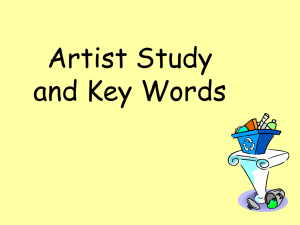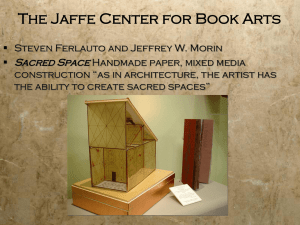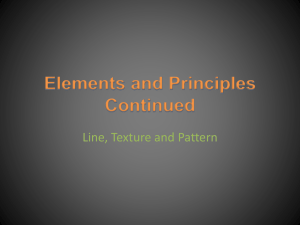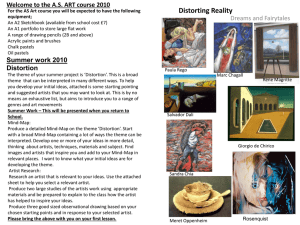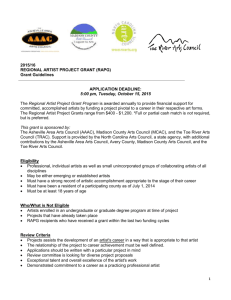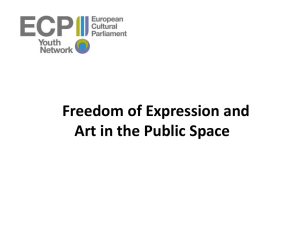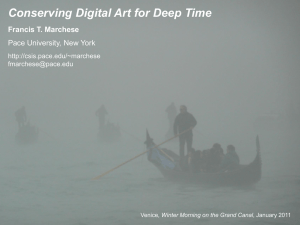The Artist in the Institution, Mick Wilson
advertisement
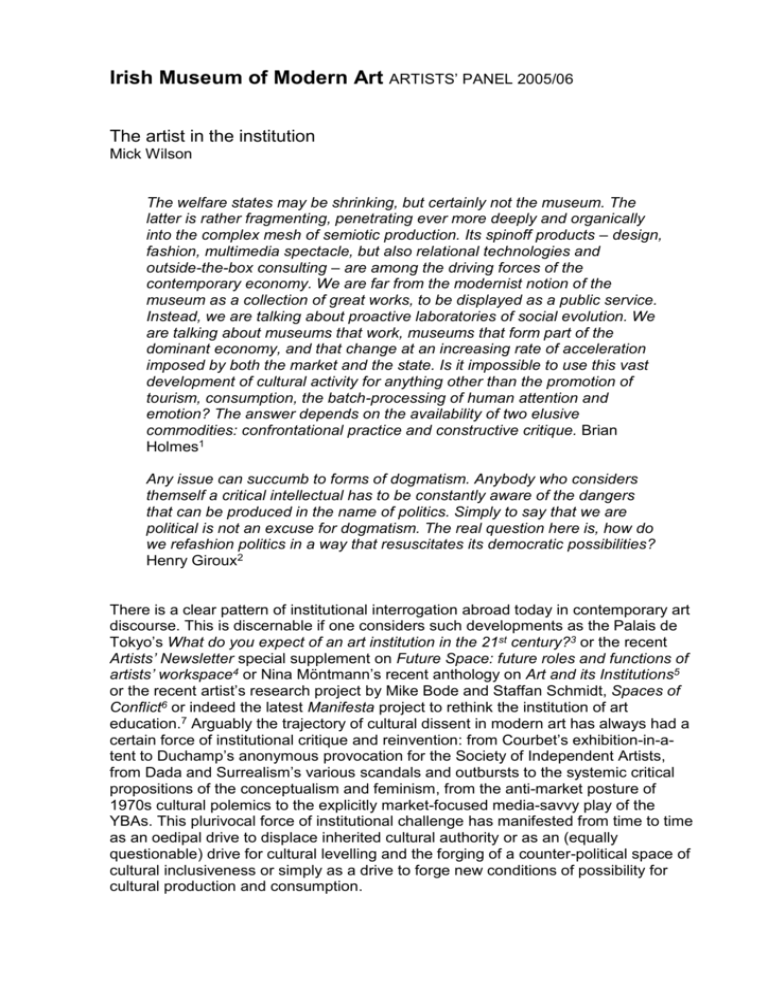
Irish Museum of Modern Art ARTISTS’ PANEL 2005/06 The artist in the institution Mick Wilson The welfare states may be shrinking, but certainly not the museum. The latter is rather fragmenting, penetrating ever more deeply and organically into the complex mesh of semiotic production. Its spinoff products – design, fashion, multimedia spectacle, but also relational technologies and outside-the-box consulting – are among the driving forces of the contemporary economy. We are far from the modernist notion of the museum as a collection of great works, to be displayed as a public service. Instead, we are talking about proactive laboratories of social evolution. We are talking about museums that work, museums that form part of the dominant economy, and that change at an increasing rate of acceleration imposed by both the market and the state. Is it impossible to use this vast development of cultural activity for anything other than the promotion of tourism, consumption, the batch-processing of human attention and emotion? The answer depends on the availability of two elusive commodities: confrontational practice and constructive critique. Brian Holmes1 Any issue can succumb to forms of dogmatism. Anybody who considers themself a critical intellectual has to be constantly aware of the dangers that can be produced in the name of politics. Simply to say that we are political is not an excuse for dogmatism. The real question here is, how do we refashion politics in a way that resuscitates its democratic possibilities? Henry Giroux2 There is a clear pattern of institutional interrogation abroad today in contemporary art discourse. This is discernable if one considers such developments as the Palais de Tokyo’s What do you expect of an art institution in the 21st century?3 or the recent Artists’ Newsletter special supplement on Future Space: future roles and functions of artists’ workspace4 or Nina Möntmann’s recent anthology on Art and its Institutions5 or the recent artist’s research project by Mike Bode and Staffan Schmidt, Spaces of Conflict6 or indeed the latest Manifesta project to rethink the institution of art education.7 Arguably the trajectory of cultural dissent in modern art has always had a certain force of institutional critique and reinvention: from Courbet’s exhibition-in-atent to Duchamp’s anonymous provocation for the Society of Independent Artists, from Dada and Surrealism’s various scandals and outbursts to the systemic critical propositions of the conceptualism and feminism, from the anti-market posture of 1970s cultural polemics to the explicitly market-focused media-savvy play of the YBAs. This plurivocal force of institutional challenge has manifested from time to time as an oedipal drive to displace inherited cultural authority or as an (equally questionable) drive for cultural levelling and the forging of a counter-political space of cultural inclusiveness or simply as a drive to forge new conditions of possibility for cultural production and consumption. In recent decades various cultural institutions – museums, colleges, galleries, arts funders, studio complexes and so forth – have attempted in various ways to recast the institutional culture of cultural institutions.8 Initiatives range from the more pedestrian outreach and education programmes (for example, the familiar free public lecture on a current show or the children’s immersive workshop) to the more thoroughgoing re-invention of an institution as a space without a building (for example, City Arts in Dublin or, in a different spirit, Manifesta and its mobile network of collaborators constantly re-jigging agendas and locales). There is also the construction of the museum as a space of leisure and conspicuous consumption (for example, MOMA); there is the art institution as entrepreneurial cultural propertyholding company (for example, Temple Bar Cultural Trust); there is the art institution as an agent of long-term embedded cultural practice that seeks to disappear from the media-scape in an attempt to merge with the everyday of a given social situation or group (for example aspects of Grizedale’s programme). The larger backdrop of such diverse institutional strategies is the radical re-drafting of the political-economic dispensation whereby neoliberal economic policies have restructured the institutional ecology of public/private spaces. The very ideas of “public culture” and of “dissent” have tended to be absorbed into a subset of culturalinstitutional rhetorics while simultaneously being increasingly displaced from mainstream political practice and language.9 While, on the other hand, the central institutional matrix of the art world, the global contemporary art market remains relatively uninterrogated, under-described and mostly obscured to “outsiders.”10 It is no easy thing for an artist to forge a path through such a complex matrix of micro- and macro-processes. Most often the encounter between an artist and a specific institution is determined by the many small tensions of a very local and very specific contingent set of circumstances. Consider the intersection of art/not-art and the broader cultural managerialism of the European capital of culture project and out of this intersection and multi-institutional collaboration the realisation of the Cork Caucus project11; consider the avowedly critical artist turned hired civil/public servant12; consider the artist attempting to forge a means of survival as an artist and not as another type of labourer in a service economy; consider the artist on the international art residency circuit and so on. In each of these situations a complex play of determinations is at work: there is no simple fool-safe plan to guide us through these tricky contradictory moments of institutional negotiation. Each of these situations is inflected in turn by a complex economy of reputations and status. This institution is good for that artist to be associated with; this artist is good for that institution to be associated with; this artist can be the means for these two institutions to transact a relationship between themselves so that established cultural value and emergent trendy cultural value can be traded off against each other in a mutually consolidating manner. The celebrity cultural manager- whether in the guise of private gallerist, independent curator, or institutionally ensconced head-ofexhibitions, keeper-of-off-site projects, or broker-of-networks or whatever- is an image that acts as a paradigm of these paradoxes. The celebrity cultural manager is imaged as a gate-keeping figure who seems to oversee the movement of artists inand-out of institutional orbits. The contradictory and multiple valencies of these exchanges between artists and institutions can often tempt us toward a kind of mythic thinking as a substitute for analysis of intractably complex exchanges and interactions. Given this summary, and admittedly flawed, overview of contexts, certain questions continue to trouble: How do we go about re-imagining the institutional ecology of our culture? How do we achieve agency within these complex structural dynamics? How do we negotiate a compromise between inherently complacent, self-regarding, denatured and frustrating inherited institutional frames and often exploitative and crass unregulated market spaces and emergent processes? How do we achieve legitimation from our larger social world for our idiosyncratic projects of communication, expression, invention, reflection, critique, experiment or whatever? How do we work here and now? How do we cope? Don’t say it’s all bad… The foregoing is not proposed as a lament for a-world-gone-bad: rather, it is a question of trying to attend to the contradictions of our working contexts. These contradictions are unstable. This means that unequivocal denunciations (the market is bad; the museum is dead; the artist is a victim; the institution is the power; the creative educator is uncreative) are of no real use, even rhetorically. However, this does not mean that we can forego any overview analysis and simply cope locally with what works for us today. We, today, here, locally, now are enmeshed in all this other stuff. As Brian Holmes suggests above, a key transformational process, which may occasionally achieve agency but also cogency, is critical practice: a way of doing that always asks questions of ourselves and our desires as well as asking these questions of the agendas of our collaborators. There is no real value or critical impetus in challenging an institution, if we are not also challenged in the very same moment. As artists engaging with institutions and (frankly) bitching about power and privilege and the often-groundless advancement of others, it would seem we must evolve into something more self-aware and less-self-exceptionalising. We have very little else but the resource of a double-edged scrutiny that simultaneously critiques both sides of the encounters, the exchanges and the transactions that make up our day. This is a very old-fashioned idea of ethics: it is not about being in the right, being correct or being proper; it is not about worthiness; it’s about wakefulness. We are never fully awake to ourselves of course, that’s why other people are required to call us names, and keep us on our toes. Of course, just being in an institution is often enough to hide yourself away from yourself. But then again you don’t have to be in an institution, to hide behind one … “The artist in the institution” - this must move from being a “situation” to being a reciprocally transformative “dynamic.” This is not an easy thing. Why would we want it to be? Then again try being an old grey cardigan talking about landscapes, nudes, and colour. That’s real hard work... Mick Wilson Artist, Writer and Head of Research and Postgraduate Study, NCAD 2006 Brian Holmes (2004) “A Rising Tide of Contradiction. Museums in the Age of the Expanding Workfare State.” [http://www.republicart.net/disc/institution/holmes03_en.htm] (22/8/06) 1 Henry Giroux (in interview with Sina Rahmani) (2005) “Rethinking Politics, Education, and Hope After Bush,” Chapter 4 of Against the New Authoritarianism: Politics After Abu Ghraib. Arbeiter Ring Publishing. p. 197. 2 3 Jérôme Sans and Marc Sanchez (eds.) (2002) What do you expect from an art institution in the 21st Century? Paris: Palais de Tokyo. Susan Jones (ed.) (2005) Future Space: future roles and functions of artists’ workspace, London: The Artist’s Information Company. 4 5 Nina Möntmann (2006) Art and its Institutions: Current Conflicts, Critique and Collaborations, London: Black Dog Publishing. 6 This is an exhibition and publication project which is based upon a series of interviews carried out in 12 locations, 6 exhibiting institutions and six educational institutions in 2004. This was conducted through the framework of a joint PhD in Fine Art through Göteburg University. 7 Manifesta 6 was cancelled this year having been due to take place in Nicosia Cyprus. It had an international art school as the major component of the biennale which was planned to take place between September and December 2006. See www.manifesta.org There is, on the one hand, a corporative move to deploy museum brands such as “Guggenheim” in Bilbao for instance and, on the other hand, an ostensibly liberatory move to generate something akin to a renewed public sphere as in Charles Esche programme at Rooseum in Sweden. 8 9 For example, Henry Giroux, the American advocate of critical cultural pedagogies, in his recent work has underlined the profound loss of a language of “the public good” from mainstream political discourses. 10 However, see Louisa Buck (2004) Market Matters: The dynamics of the contemporary art market, London: Arts Council of England; and Iain Robertson (2005) Understanding International Art Markets and Management, London: Routledge. See also the Maria Lind curated seminar on “Art & Economy” (June 2005) Rotterdam: Witte de With & TENT. See [http://pzwart.wdka.hro.nl/fama/programme2/archive/2004-2005/artandeconomy] (22/8/06) 11 12 See http://www.corkcaucus.org/ There are numerous instances of artists and independent cultural workers, rehearsing ostensibly critical positions, and subsequently taking on tenured institutional roles such as those of educator, administrator and programmer within a range of public bodies.


